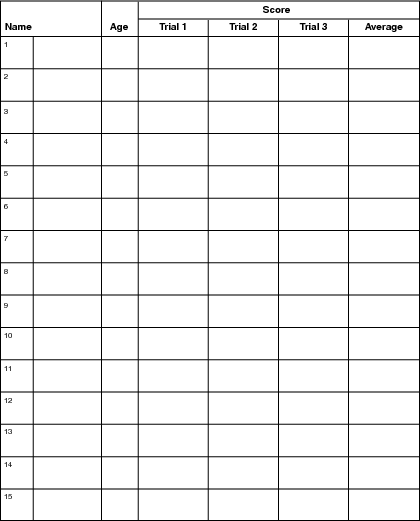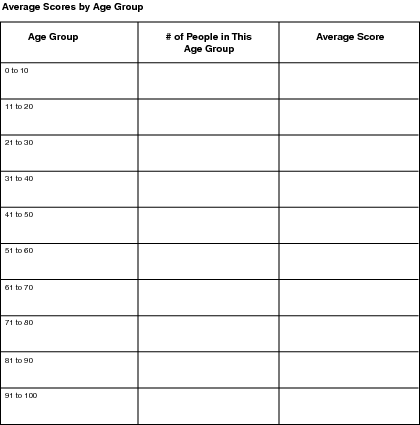Think about the members of your family, and the families of your friends. Not just your immediate family, but your extended family. You may have grandparents-maybe even great-grandparents-and aunts and uncles, parents, cousins, and brothers and sisters.
As you no doubt have noticed, there are bound to be lots of differences among the members of an extended family. Some are old, others are young. Some might be tall, and others short. You might have cousins who have very blonde hair, while your and your sister's hair is brown.
Additionally, when you observe members of your family, or of other people's family, you'll notice that some move more quickly than others. And, chances are, it's the younger folks that are running laps around the older ones.
The gradual slowing down that normally occurs as a person ages doesn't mean that he or she gets lazy, or isn't able to be active. There are plenty of people in their 70s, 80s, and even 90s who exercise regularly. Some even participate in long-distance walking, biking, swimming, and running competitions.
Generally, however, older folks tend to take a little longer to do something that involves physical movement than younger ones. Their bodies slow down, it takes longer to complete tasks, and they experience a slowing in reaction time, as well. In this section, we'll look at the issue of reaction time-or reflexes-and how it varies between younger and older people.
So What Seems to Be the Problem?
The problem that we'll attempt to solve with the experiment outlined in this section is whether older people have slower reaction times than younger people.
From the content of this section so far, and from your daily observations, you probably have an idea that indeed, that is the case.
Even so, it's a question worth investigating, and this experiment will enable you to do so. First, however, let's take a look at exactly what reaction times and reflexes are.
A person's reaction time is a measure of how fast they can respond to a situation or stimulus. Reaction times are linked to reflexive actions, or actions that you take without first thinking about them.
This science fair experiment uses an electronic toy to measure the reaction time of people of different ages. It's easily done, but requires careful record keeping so that you'll be able to track and record results.
You could use "Does Age Affect Reaction Time?" as the title for your science fair project. Or, you could choose from one of these titles:
- Testing Reaction Times of Various Age Groups
- Is Reaction Time Age Related?
- Reaction Time: Kids vs. Adults
Keep reading to see how the problem you'll be attempting to solve during the course of this experiment relates to everyday life.
What's the Point?
If you're driving or riding your bike, and the person in front of you stops without any warning, your reflexive action probably will be to slam on your brakes, or to swerve out of the path of the car or bike before you.
Whether you manage a safe stop or end up hitting the vehicle in front of you depends largely on your reaction time. The quicker you get the brakes on or begin steering away from the other vehicle, the better chance you have at avoiding an accident.
It's important to have an idea of how good your reaction time is, and to keep an eye on it as you get older. Studies have shown that, typically, a person's reaction time is at its best when a person is in his or her late 20s. Reaction time improves from infancy into the late 20s, due, it's thought, to increased experience.
For example, you'll have a better idea how to react, and presumably will react more quickly, the fourth or fifth time that a car or bike stops suddenly in front of you than the first time it happens.
After the late 20s, however, reaction times typically begin slowing down. The slowdown occurs gradually until the 50s or 60s, and gets more pronounced as a person gets into his or her 70s and beyond.
The experiment in this section will allow you test these statements, and find out whether the older folks in your family have reaction times that are typical of their ages, or whether they defy scientific findings.
The control you'll use in your experiment will be a group of people who are between the ages of 20 and 30. This group should be at its reflexive peak. Other groups of people-both older and younger-will represent the variables.
Of course, reaction time will vary from person to person, and you can't assume that every 26-year-old will react more quickly than every 18-year-old. Plus, the difference in reaction times between people of various ages may be tiny-measured in increments of seconds, not seconds. Still, you should be able to gather enough information to make a comparison.
What Do You Think Will Happen?
Based on what you've read and observed, chances are that your hypothesis is that younger people react more quickly than older ones. If you've reached that conclusion, then you can carefully conduct your experiment to learn if your results will support your hypothesis.
During the experiment, you'll test the reflexes of people in different age groups using an electronic toy available in toy stores and from Internet sources. The toy is most commonly known as a Bop It Extreme.
Before we tell you exactly how the experiment will work, take a few minutes to think about what you've observed while watching people over the course of your lifetime. Does it seem to you that younger folks are quicker and react faster than older ones? Do you think that someone in his or her 20s has a better reaction time than you do?
So go ahead and take your best guess, and then begin preparing to do the experiment that will test your hypothesis.
Materials You'll Need for This Project

You'll need to have a Bop It Extreme for this experiment. You should be able to find one in your local toy store, or you can order one on the Internet.
The Bop It Extreme gives random, rapid commands to which the user must respond. It forces the person playing to respond quickly, before the next command is issued. The user is told to flick, spin, pull, or twist one of four extending parts that correspond to the commands. One point is scored each time a player performs a command correctly within the short, allotted time period.
The turn ends when the player is no longer able to complete the tasks of flicking, pulling, spinning, and twisting. The machine notes each action performed correctly with a drumbeat sound, and every 10 correctly completed actions with a crashing cymbal sound.
Once you have the Bop It Extreme, the only other materials you'll need for this experiment are as many people of different ages as you can round up, and paper and pencils with which to record your results.
The Procedure
You'll need to test a lot of people in order to complete this experiment, and that will require some time and planning. The good news is that you can space it out over a period of time, just as long as you begin far enough in advance.
Plan to take the Bop It Extreme with you to family gatherings, your friends' houses, and other places so that you get a chance to test people of different ages. If you know someone who lives in an apartment or other facility for elderly people, you may be able to test all of your older participants in just one visit. Remember to take your notebook or journal along so you can record scores.
You'll need to have at least three people from each of the age groups listed here:
- 0 to 9
- 10 to 19
- 20 to 29
- 30 to 39
- 40 to 49
- 50 to 59
- 60 to 69
- 70 to 79
- 80 to 89
- 90 to 99

Five people from each age group would be better than three, but if you can't locate that many, three will do. Just be sure that you have the same number of people from each category.
Once you've identified your participants, you should proceed with your experiment, following the steps listed below. This procedure will be the same for each person participating.
- Prepare a chart on which to record information from each person who participates. Your chart should look like the one shown in the next section, "Keeping Track of Your Experiment." If you want, you can record the information directly onto that chart, but you'll need to recopy it if you want to include the results with your display.
- Give a player three practice turns so he or she is familiar with how the Bop It Extreme operates.
- Have a player take three turns (three trials) and record the number of actions correctly completed.
- Calculate the average number of points scored to the nearest whole number and record that number on the data chart.
- Repeat these steps for the rest of the people you'll be testing. Ideally, you'll test 45 people, or 5 from each group.
Keeping Track of Your Experiment
This experiment requires that you keep good records, since you'll be working with so many people. Be sure to record your data accurately as each person participates.
This first chart is the one on which you'll record information about each participant.
On the second chart, you'll record the average scores of each age group. Once you've averaged the scores of each group, you can make a bar graph illustrating that information.
Once you've averaged the scores of each age group, it shouldn't be difficult to use that information to make a bar graph.


Further Investigation
If you enjoyed conducting this experiment, you could take it a step further by noting the time of day at which each participant played the game. Do you think that the time of day might affect someone's reaction time?
Because studies suggest that males typically have faster reaction times than women, you also could note the sex of each participant and see if that theory proves to be correct or incorrect.




